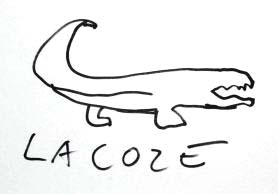Wrapping Up the Week
Friday has finally arrived, and not a day too soon. Here's a wrap up of some of my week's best reading. Hope you enjoy it as much as I did.
On Branding
These days, the best way to get people's attention is not to engage consumers with a brand, but to host or facilitate a context for people to engage with one another.
From Productivity: Meet, Greet, Then Market by J. Walker smith, president of Yankelovich Partners. He's right on. It's all about value: With all the choices out there you better do more for me than just tell me how great your product is. I want real value. (Link via Scott Karp's fantastic Publishing 2.0.)

From monochrom Brandmarker. People were asked to draw logos from memory. Check out the results. Think about how deeply logos become burnt into our conscienceless.
On Sports
But one of the fascinating things about sports, it seems to me, is that when it comes the way we think about professional athletes, we're all liberals (without meaning to be, of course). We give people lots of chances. (Think Jeff George). We go to extraordinary lengths to help players reach their potential. We're forgiving of mistakes. When the big man needs help with his footwork, we ship him off to Pete Newell for the summer. We hold players accountable for their actions. But we also believe, as a matter of principle, that players need supportive environments in order to flourish. It would be nice if we were as generous and as patient with the rest of society's underachievers.
From Curious Guy: Malcolm Gladwell, an email exchange between Malcolm Gladwell and Bill Simmons. That quote is from Gladwell and I never really thought of it that way. Interesting . . .
"I found the original photograph in the archives of Sport Magazine (where Schaap later worked as editor in chief)," Siegel said. "It was an action shot of Jerry West dribbling down the court from one of the Lakers' games. I sketched it, cleaned it up a bit and stylized it. I streamlined the tracing I made  (and) slimmed it down a little bit  so it would work in all applications."
From If West is the NBA's logo, should he be?, the above quote is Alan Siegel commenting on his creation of the red, white and blue NBA silhouette logo. The article is a great history of the professional sports, specifically the NBA's, branding efforts.
On Design
There’s no two ways about it; style matters. And style applied to a web page design is not always just style for its own sake. It’s often a vital supporting element in effective design. Competent designers understand this. The nattering nabobs and little design generals of the online forums do not. Which is why there’s a difference between getting paid and getting comments in a forum.
From The Layers of Design: the style layer by Andy Rutledge (whose writing I've been enjoying quite a bit lately). It's kind of scary how nicely the article compliments my little design rant, which just happened to quote a different Rutledge article.
I suspect what I’m really against is what that term “graphic design� has come to represent, i.e. synonymous with business cards, logos, identities and advertising, and, again simply put, those are things I’m just not interested in. To me that idea of “graphic design� is as far removed from my interests as being a milkman or a lawyer. In fact, I’d rather be a milkman. This problem of definition is the same as what happened to the word “modernism�. I consider myself a modernist, but with a lower-case m. in the sense of believing in appropriate, reasoned change. Yet most people consider upper-case Modernism, at least in art and design, as being a fixed, formal style. So I’m really just reacting in some knee-jerk way to the fact that both “graphic design� and “modernism� are so defined in the minds of others, and it makes it difficult to communicate; it’s so easy to be misrepresented.
From Stuart Bailey Speaks Up an interview with the Dutch designer. Feeling pigeonholed sucks.